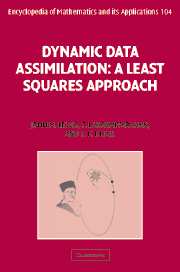Book contents
- Frontmatter
- Contents
- Preface
- Acknowledgements
- PART 1 GENESIS OF DATA ASSIMILATION
- PART II DATA ASSIMILATION: DETERMINISTIC/STATIC MODELS
- PART III COMPUTATIONAL TECHNIQUES
- PART IV STATISTICAL ESTIMATION
- PART V DATA ASSIMILATION: STOCHASTIC/STATIC MODELS
- PART VI DATA ASSIMILATION: DETERMINISTIC/DYNAMIC MODELS
- PART VII DATA ASSIMILATION: STOCHASTIC/DYNAMIC MODELS
- PART VIII PREDICTABILITY
- 31 Predictability: a stochastic view
- 32 Predictability: a deterministic view
- Epilogue
- References
- Index
32 - Predictability: a deterministic view
from PART VIII - PREDICTABILITY
Published online by Cambridge University Press: 18 December 2009
- Frontmatter
- Contents
- Preface
- Acknowledgements
- PART 1 GENESIS OF DATA ASSIMILATION
- PART II DATA ASSIMILATION: DETERMINISTIC/STATIC MODELS
- PART III COMPUTATIONAL TECHNIQUES
- PART IV STATISTICAL ESTIMATION
- PART V DATA ASSIMILATION: STOCHASTIC/STATIC MODELS
- PART VI DATA ASSIMILATION: DETERMINISTIC/DYNAMIC MODELS
- PART VII DATA ASSIMILATION: STOCHASTIC/DYNAMIC MODELS
- PART VIII PREDICTABILITY
- 31 Predictability: a stochastic view
- 32 Predictability: a deterministic view
- Epilogue
- References
- Index
Summary
In this chapter we describe a deterministic approach to stability and predictability of dynamic systems. While the classical stability theory deals with characterizing the growth and behavior of perturbations around an equilibrium state of a system, the goal of the predictability theory is to quantify the growth and behavior of infinitesimally small perturbations superimposed on an evolving trajectory – be it stable, unstable or chaotic – of the given dynamical system. Any two states that are infinitesimally close to each other are called analogs. Thus, predictability theory seeks to characterize the future evolution of analogous states. Since every trajectory starts from an initial state, predictability analysis is often recast as one of analyzing the sensitive dependence on initial state. Despite this difference in goals, both stability and predictability theories depend heavily on the same set of mathematical ideas and tools drawn from the spectral (eigenvalue) theory of finite dimensional (matrix) operators.
The goals and problems related to deterministic predictability theory are reviewed in the opening Section 32.1. Section 32.2 through 32.5 provide a succinct review of stability theory of dynamical systems. Predictability analysis using singular vectors is developed in Section 32.6. A summary of a fundamental theorem of Osledec leading to the definition of Lyapunov vectors and Lyapunov indices is given in Section 32.7. This section also contains two related algorithms for computing Lyapunov indices. The concluding Section 32.8 describes two methods for generating deterministic ensembles using which one can assess evolution of the spread among the trajectories measured among other things through the sample covariance.
Information
- Type
- Chapter
- Information
- Dynamic Data AssimilationA Least Squares Approach, pp. 581 - 627Publisher: Cambridge University PressPrint publication year: 2006
